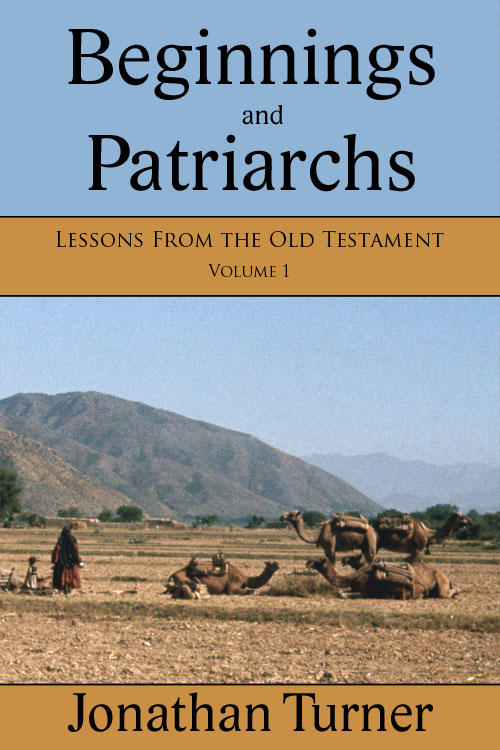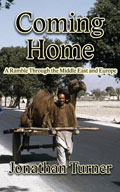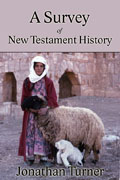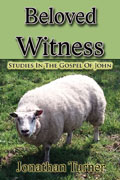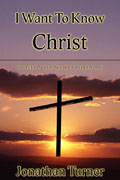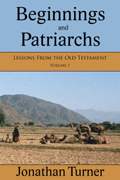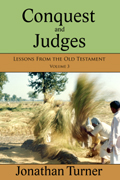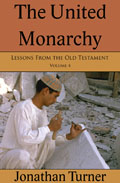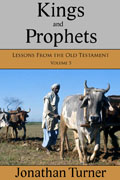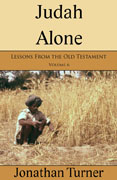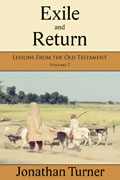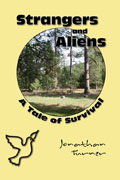Click on the cover image to purchase.
Table of Contents
Introduction – Why Bother with the Old Testament?
1 Introduction to the Bible
2 A Good Beginning
3 The First Family
4 All Fall Down
5 Death and Rebirth
6 God Starts Over
7 A Test of Integrity
8 The Great Debate
9 A Whisper of His Power
10 The Beginnings of Jewish History
11 Unlikely Promises
12 Which Way Ya Gonna Go?
13 Credited as Righteousness
14 Walking By Sight
15 Covenant and Promise
16 Sodom and Gomorrah
17 Where the Rubber Meets the Road
18 How to Pick a Wife (Being Worth the Picking)
19 Birthright and Blessing
20 Bargains, Bargains
21 Family Values
22 Making Amends
23 Let’s Visit the Neighbors!
24 Sold Down the River
25 Framed and Forgotten
26 From Slave to Ruler
27 When the Chickens Come Home to Roost
28 God Intended It for Good
Appendix – The Art of Teaching
Bibliography
About the Author
Introduction
Why Bother with the Old Testament?
Christians naturally gravitate toward the New Testament. It is natural because it is in the New Testament that we find the accounts of Jesus’ life and ministry. It is the New Testament which explicitly defines what the followers of Christ should believe and how they should act. It is the New Testament which tells us about the first disciples and the early church.
The New Testament not only provides the basis for our faith and practice, it also supersedes the Old Covenant. The reason it supersedes it is that Jesus has fulfilled the Old Covenant. The Mosaic Law which defined the terms of the Old Covenant is no longer in force – not because it was annulled or abrogated, but because Jesus fulfilled it. (Yes, that even includes the ‘10 Commandments’!) The New Covenant is based on an entirely different principle – not that of Law, but on a changed personality. That’s what the ‘new birth’ or being ‘born again’ is all about. We do what is right, not because a law tells us to but because, in Christ, we have become a new creature and doing right is the natural thing for that new nature to do. An inherent part of the new creation is a natural desire to do what is right. We are in the process of becoming like Christ, and the more we become like Him, the more natural it is avoid sin and live as God wants us to live.
In view of this fundamental change, many Christians and congregations tend to ignore the Old Testament. While no Christian would say that the Old Testament is unimportant, they often treat it that way in practice. At best they will use a few of the more dramatic incidents to entertain the children in Sunday School.
Others will selectively use a few portions of the Old Testament – typically the first few chapters of Genesis, Proverbs, a few of the Psalms and Isaiah’s prophecies of the coming of the Messiah. They will skim over the rest or overlook it entirely.
However, we tend to forget that the Old Testament was the only Bible the first Christians knew. At first they did not have the gospel accounts in written form. Luke had not yet written his history of the early church. Paul and the other Apostles had not yet written their inspired letters. The Revelation had not yet been given to John.
Not only did the first Christians not have the New Testament, their view of the Old Testament writings was very different than ours often is. Time after time the New Testament writers appealed to the Old to substantiate what they were saying. Not only that, they saw the Old Testament as immanently practical. It could not only lead someone to salvation in Christ, but was also a help in the dilemmas of daily living for God. Paul wrote to Timothy, “…from infancy you have known the holy Scriptures, which are able to make you wise for salvation through faith in Christ Jesus. All Scripture is God-breathed and is useful for teaching, rebuking, correcting and training in righteousness, so that the man of God may be thoroughly equipped for every good work.” (2 Timothy 3:15-17 NIV)
In the middle of his argument that Jesus is superior to Moses, and the New Covenant supersedes the Old, the writer of Hebrews says, “For the word of God is living and active. Sharper than any double-edged sword, it penetrates even to dividing soul and spirit, joints and marrow; it judges the thoughts and attitudes of the heart.” (Hebrews 4:12 NIV)
I have found this true in my own experience. Though Christ has fulfilled the Law and it is no longer in force, the Old Testament is still God’s Word and it still lives. While studying the Old Testament I have been amazed at how practical and applicable it is. I have been amazed at the insights we can gain from it. For example, the book of Jonah radically changed my understanding of God’s character and the lengths to which He will go in order to redeem people.
The lessons in this and the volumes which follow are intended as an overview or survey of the Bible. Not every story is covered (though lessons can easily be added). Because this is a survey, not every detail is covered. The intent is not to present a scholarly commentary but to give people a good understanding of the major events and, more importantly, provide practical lessons and applications for our lives today.
Since many of these lessons were originally intended for the youth group at a congregation where I served, some of the applications are slanted toward young people. Some of you might be surprised that lessons intended for youth have so much content. I think that we often sell our youth short. One reason our youth seem shallow is that we don’t expect more of them. Perhaps they pursue the trivial because that’s what we provide them. Even if it may not seem that they always listen, I am convinced that youth often absorb more than they let on.
My preferred method of teaching is to ask questions about a text and encourage discussion about it. These lesson notes don’t always reflect that method. In practice, I often turn the statements in the lessons into questions. Sometimes the answers are surprising and lead the discussion into unexpected territory. Sometimes the discussion sparks questions from the students which might not fit the lesson-plan. I think it’s important to follow those questions up anyway because they are indications of the real spiritual struggles the students are facing, right now. Strike while the iron is hot, even if it means abandoning your time-schedule for presenting the material or, skipping some altogether. The students’ spiritual growth and their relationship to Christ is more important than getting through a particular amount of material.
The lessons in this volume cover the period of time from the Creation through the life of Joseph. To put it another way, they are taken from the books of Genesis and Job.
Introduction to the Bible
The Bible is the primary means we have for knowing God, the plan of redemption and His will for our lives. It is the only unchanging benchmark by which we can measure, not only our own lives and spiritual progress but also, the church and the world around us.
In spite of the Bible’s importance, there is a great deal of ignorance about it. Even those who have been raised in Christian homes and go to church regularly are often unfamiliar with the stories of the Bible, much less its teachings.
I. Major Divisions Of The Bible
The Bible is divided into two major sections. What are they?
The two major sections are the Old and New Testaments. This raises another question. In everyday language, we don’t use the word ‘testament.’ What does it mean?
‘Testament’ is another word for ‘covenant.’ But what is a covenant?
A covenant is a binding agreement between two parties. It is usually initiated by the stronger one. It is sort of like a contract, but with a very important difference: In covenant, the parties are under obligation to help each other fulfill the terms of the relationship. In practice, this means that when someone is in covenant relationship with God, God provides what is necessary for that person to keep covenant with Him. In a covenant there are:
1) Parties
In other words, who the agreement is between.
2) Stipulations
These are the things which either party agrees to do. On the surface, some covenants may seem very one-sided. One of the parties agrees to do a long list of things, while the other party doesn’t have to do much at all. But remember that included in the idea of covenant is helping each other to fulfill it. Even if one of the parties doesn’t have a lot of stated obligations, he still has the responsibility of helping the other party fulfill the agreement.
In the Old Testament the act of keeping (or helping to keep) covenant is described by the Hebrew word hesed. It is often translated ‘kindness’ or ‘loving-kindness.’ In other words, the chief characteristic of covenant is not “do this, or else” as it is in the idea of contract, but, “I want what is best for you.” This is carried over into the New Testament as the concept of grace.
3) Promises
These are the benefits which occur from keeping the covenant, as well as the consequences of breaking it. Again, the emphasis is on what is good for the parties involved. Rather than consequences of breaking covenant being regarded as pun-ishment, keeping the agreement is to spare the agreeing party from what would otherwise occur.
An understanding of covenant is essential to understanding the Bible. There is a lot in the Bible which may seem arbitrary or which doesn’t make a whole lot of sense until you look at it in the context of covenant. This series of lessons gives an overview of the major events or stories of the Bible – but they do so through the lens of covenant.
There is another biblical concept which is also closely linked to that of covenant: that of the Remnant. We will see that while most people have broken their covenants with God, there has always been a remnant which remained faithful. This is a theme which is repeated over and over.
II. Who Wrote The Bible?
In the broad sense, God wrote the Bible. “Above all, you must understand that no prophecy of Scripture came about by the prophet’s own interpretation. For prophecy never had its origin in the will of man, but men spoke from God as they were carried along by the Holy Spirit.” (1 Peter 1:20-21 NIV)
Though God is the author, He worked through people to record His message. He inspired many different writers. For the most part, God did not dictate the Bible but allowed the different personalities, writing styles and circumstances of writing to influence how the message was recorded.
The people who wrote the Bible are called prophets. A prophet is not necessarily someone who speaks or writes about future events (though they might do that as well), but one who speaks or writes on behalf of God.
It’s important to note that the prophets recorded what is important in terms of God’s covenant and covenant history. This is one reason why many details we would like to know are left out and, on the surface, why much that is written seems less important to us. The Bible is not a record of history, but of covenant history.
III. Eras Of Covenant History
In terms of covenant, the Bible is divided into three main eras.
1) The Patriarchal age
This age extends from creation to Mt. Sinai. In it, God dealt mainly with heads of families. Covenants were made with them and their heirs.
2) The Jewish age
This age extended from Mt. Sinai to Calvary. During this age, God established a covenant with the Jewish people. It was a national covenant, rather than a strictly personal one.
3) The Christian age
This is the age we live in. It extends from Calvary to the final judgment. In it God makes a covenant relationship, not with heads of families nor with nations but, with individuals. We are included in the covenant not because we belong to a particular family or because we belong to a specific nation but because we each, individually, have chosen to enter into it.
IV. How is the Bible organized?
The Bible is not organized by topic. For the most part it is not organized in time sequence. It is sort of organized by type of literature. In other words, various books of similar type or literary style are grouped together.
1) The Old Testament
The 39 books of the Old Testament are grouped this way:
5 books of Law (Genesis is included in the books of Law, even though it is not associated with the Law of Moses, because it describes the events leading up to God’s choosing of the Jewish people and the giving of the Law. A second reason is that it was written by Moses who also penned the other 4 books.)
12 books of History
5 books of Poetry (Also known as the ‘Wisdom Literature.’)
5 books of the ‘Major’ Prophets
12 books of the ‘Minor’ Prophets
Note that the ‘Minor’ Prophets are not called that because their message is less important, but because the length of their books is shorter than that of the ‘Major’ Prophets.
2) The New Testament
The 27 books of the New Testament are grouped as:
4 Gospels (‘Gospel’ means ‘good news.’ The gospels record Jesus’ ministry – particularly His death, burial and resurrection.)
1 book of History
13 Pauline Epistles (In other words, letters written by the Apostle Paul.)
8 General Epistles (These are letters written by other people besides Paul.)
1 book of Prophecy
V. Old Testament Introduction
Of the two major divisions in the Bible, the Old Testament is not only much the largest, it is the most complex. It covers more geographic territory, it covers a larger span of history, it includes more types of literature, more people had a hand in writing it and it was written over a much longer period of time.
Why study the Old Testament?
Since we live in the era of the New Covenant, what purpose or benefit is there is studying the Old? After all, Jesus has fulfilled the Law and the prophets (Matthew 5:17).
One reason to study the Old Testament is that it gives invaluable background information which helps us to understand the New Testament. Much of what is written in the New Testament assumes a knowledge of the Old. For example, the Gospel of Matthew often mentions how various aspects of Jesus’ life and ministry fulfill prophecies in the Old Testament. Paul assumes the readers of the book of Romans have knowledge of the Mosaic Law. The book of Hebrews assumes a knowledge of the Levitical priesthood and many other Old Testament details.
Another reason to study the Old Testament is that human nature hasn’t changed. We can learn a great deal from how God has interacted with mankind throughout history. The lessons from many of the stories in the Old Testament are surprisingly relevant to us today.
The most important reason to study the Old Testament, however, is that it points us to Christ. “So the law was put in charge to lead us to Christ that we might be justified by faith.” (Galatians 3:24 NIV) Just as the focal point of the New Testament is Christ, so is the focal point of the Old. Every book of the Old Testament has a place in describing salvation history.
VI. Old Testament Eras
It’s easier to understand Old Testament history if it’s broken down into sections.
1) The Patriarchal age
During this era God spoke to, and made covenants with, individual heads of households. It can be divided into several distinct time periods.
a) From the creation to Noah’s flood
b) From Noah’s flood to the Tower of Babel
c) From the Tower of Babel to Joseph’s death
d) From Joseph’s death to the giving of the Mosaic Law at Mt. Sinai
2) The Jewish Age
The next major section of salvation history is the time during which the Mosaic Law was in force. During this time, God entered into covenant with an entire nation. The time periods of this age are:
a) Period of Wanderings, from the giving of the Law to the crossing of the Jordan River.
b) Period of Judges, from the crossing of the Jordan River to King Saul. The Conquest of Canaan is included in this period.
c) The United Kingdom, from the reign of King Saul until the reign of King Rehoboam.
d) The Divided Kingdom, from the reign of King Rehoboam to the Fall of Samaria.
e) Judah alone, from the Fall of Samaria to the Fall of Jerusalem.
f) Period of exile, from the Fall of Jerusalem to the Return under Zerubbabel.
g) Post-exile Period, from the Return through the ministry of Malachi.
The Old Testament ends with the book of Malachi. The Old Testament Age, however, continued until the death of Christ on Calvary. Between the two Testaments, is a period commonly called the 400 years of silence. Though no inspired writings date from this period* God was definitely at work during it. Those who were spiritually aware could see the events which had been prophesied leading up to the coming of the Christ, being fulfilled one by one.
*Some Bibles contain a section of literature which is inserted between the Old and New Testaments called the Apocrypha. These books date from the ‘period of silence’ and do provide some historical insights into the period. However, they do not meet the test of inspiration. Unlike the inspired books, the Apocrypha contains some information which is demonstrably false. It is also significant that the New Testament writers never quote from the Apocrypha and never refer to any of the books as Scripture.
